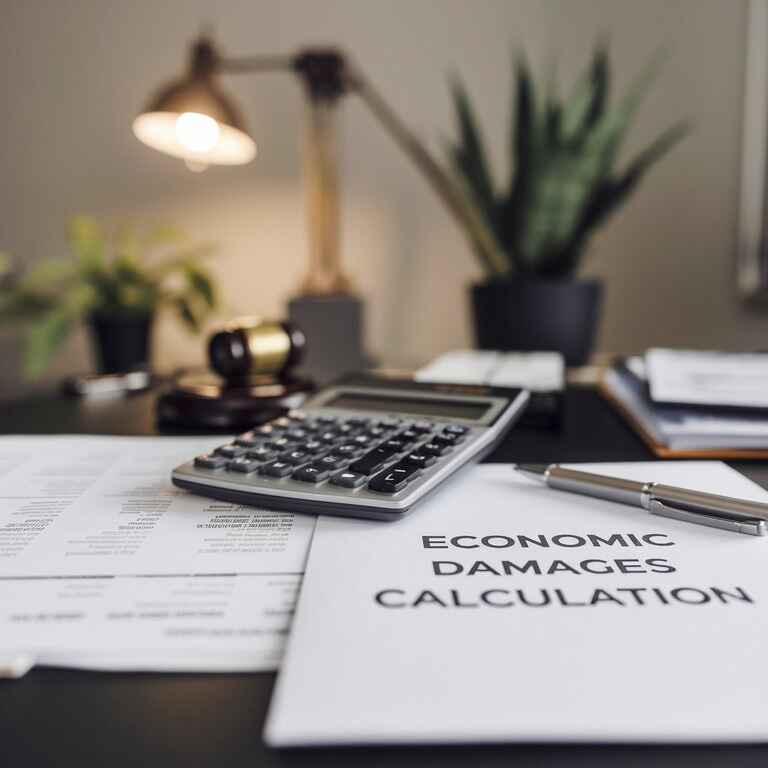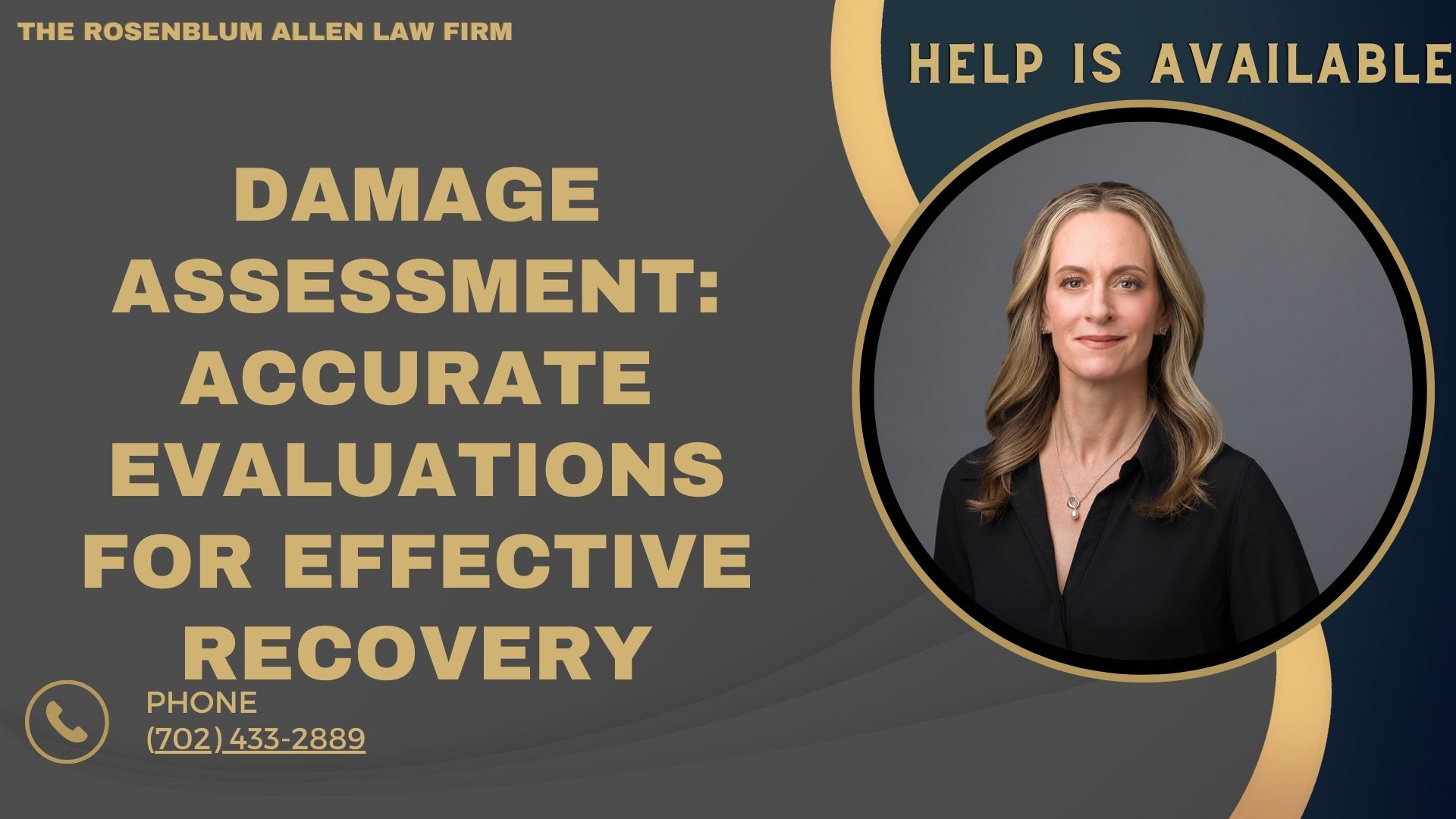Damage assessment is a critical component in personal injury cases. It determines how much compensation a victim should receive for the harm they have suffered. A damage assessment evaluates an injury’s financial, physical, and emotional impact to ensure that victims are fairly compensated for their losses.
The accuracy and thoroughness of a damage assessment are essential to the outcome of a personal injury case. Whether you’re seeking compensation for medical bills, lost wages, or emotional distress, having a clear, precise damage assessment can make or break your claim.
In Nevada, courts rely on several methods and factors to determine the appropriate compensation for personal injury victims. Understanding the process can help victims better prepare for their cases, ensuring they receive the compensation they deserve.
 The Process of Damage Assessment
The Process of Damage Assessment
Initial Steps in Assessing Damages in Personal Injury Claims
The first step in assessing damages in a personal injury claim is identifying the full extent of the damages the victim has incurred. This involves not only reviewing physical injuries but also considering financial losses, emotional distress, and other non-economic factors.
The following steps are typically involved in a damage assessment:
- Filing the claim: A personal injury lawsuit or insurance claim is initiated to seek compensation for damages.
- Gathering evidence: This includes medical records, accident reports, photos of the accident scene, and witness statements.
- Documenting the injury’s impact: Detailed documentation of both physical and emotional consequences is crucial.
Collecting Evidence: Medical Records, Witness Testimony,Specialized Opinions
The foundation of any damage assessment is evidence. This can come from a variety of sources, including:
- Medical Records: Documentation of injuries, treatments, surgeries, rehabilitation, and prognosis. Medical professionals often provide detailed reports on how the injury will affect the victim in the long term.
- Witness Testimony: Statements from individuals who witnessed the accident or the aftermath can support the victim’s version of events and the impact of the injury.
- Specialized Opinions: Professionals such as accident reconstructionists, medical specialists, and financial specialists can provide insight into the severity of the injury, the cost of treatment, and the expected long-term consequences.
Involving Experts: Role of Medical Professionals, Economists, and Accident Reconstructionists
Experts may be called in to assist with damage assessments in more complex personal injury cases. These experts provide valuable testimony that can support the victim’s case and increase the likelihood of a favorable outcome. Some of the most common experts involved in damage assessments include:
- Medical Professionals: Physicians or specialists who provide in-depth analysis of the injuries sustained and the impact on the victim’s life, including long-term care needs.
- Economists: These experts assess the financial impact of the injury, including lost wages and future earning capacity. They can also estimate the victim’s future medical expenses.
- Accident Reconstructionists: In cases involving accidents, these experts can help recreate the events leading up to the incident, adding clarity to the case and providing a stronger foundation for the damage assessment.
Types of Damages in Personal Injury Cases
Personal injury victims may be entitled to various damages, each serving a different purpose in compensating for the harm they have experienced. Damages can be broadly divided into two categories: economic damages and non-economic damages.
Compensatory Damages: Economic vs. Non-Economic Damages
Compensatory damages aim to make the victim “whole” again by reimbursing them for their losses. These damages are broken down into two main types:
- Economic Damages are quantifiable financial losses the victim incurred due to the injury.
- Non-Economic Damages: These damages are more challenging to quantify because they involve the pain, suffering, and emotional distress the victim experiences due to the injury.
Special Damages: Medical Expenses, Lost Wages, and Property Damage
Special damages are a category of economic damages that can be clearly calculated and are typically the easiest to prove in court. They include:
- Medical Expenses: This consists of the cost of treatment, surgery, medications, physical therapy, and any other medical care required for recovery.
- Lost Wages: If the victim cannot work due to their injuries, compensation for lost wages is included in the damage assessment. This can also extend to loss of future earning capacity if the victim’s injuries are severe enough to affect their long-term ability to work.
- Property Damage: If personal property, such as a vehicle, was damaged in the accident, compensation for repair or replacement costs can be assessed.
General Damages: Pain and Suffering, Emotional Distress, Loss of Consortium
General damages are more subjective and difficult to quantify, but they are essential to damage assessment. These include:
- Pain and Suffering: Compensation for the physical pain the victim has endured due to the injury. Courts often assess the severity and duration of the pain to determine an appropriate amount.
- Emotional Distress: If the victim experiences significant anxiety, depression, or trauma as a result of the injury, this can also be factored into the damage assessment.
- Loss of Consortium: This refers to losing companionship, affection, and sexual intimacy in relationships due to the injury. The spouse or family members of the injured party may be eligible for this type of damage if the injury has negatively impacted their relationship.
Punitive Damages: When They Apply and Why They Are Awarded
Punitive damages are not typically awarded in personal injury cases unless there is clear evidence that the defendant acted with extreme recklessness, malice, or willful disregard for the safety of others. These damages punish the defendant and deter others from similar behavior. In Nevada, punitive damages may be awarded in cases of gross negligence or intentional harm.

Evaluating Economic Damages
Economic damages are often the most straightforward to assess when it comes to personal injury cases. These damages are based on actual, quantifiable financial losses that the victim has experienced. Whether you’re dealing with medical bills or lost wages, these damages aim to cover the financial burden caused by the injury.
Medical Expenses: Current and Future Costs
One of the key components of economic damages is medical expenses. These include:
- Emergency room visits
- Hospital stays
- Surgeries
- Prescription medications
- Physical therapy and rehabilitation
Current and future medical costs must be considered for a comprehensive damage assessment. For example, if the injury requires ongoing treatment, such as physical therapy or frequent doctor visits, these future costs should be included. An expert medical opinion may be needed to predict future treatment, ensuring the victim’s compensation covers all anticipated expenses.
Lost Wages and Loss of Earning Capacity
If the injury keeps the victim from working, compensation for lost wages is essential. Lost wages cover the income the person could not earn because of the injury.
- Past lost wages: Compensation for time missed from work since the injury.
- Future lost wages: If the injury impacts the victim’s ability to work long-term, future earnings are also considered.
Loss of earning capacity goes beyond simple wages. If the injury affects the person’s ability to work in the same capacity or earn the same income in the future, this must also be factored in. For example, if someone can no longer perform their previous job or needs to switch careers due to their injuries, their future earning potential might be significantly impacted.
Property Damage: Evaluating Physical Losses
In many personal injury cases, personal property is also damaged. This can include vehicles, electronics, or even clothing. If the injury occurred during a car accident, for instance, the victim may be entitled to compensation for the cost of repairing or replacing the damaged property.
The assessment of property damage usually involves:
- Repair estimates: Getting an estimate from a certified mechanic or technician.
- Replacement costs: If the item cannot be repaired, determine its cost.
It’s important to document all damaged property properly, including taking photographs or videos of the damage as evidence.
Calculating Out-of-Pocket Expenses and Future Financial Needs
Out-of-pocket expenses are often overlooked, but they can add up quickly. These are costs that the victim has had to pay for directly, such as:
- Travel expenses for medical appointments
- Household help if the victim needs assistance due to their injury
- Special equipment such as wheelchairs or prosthetics
In addition to these immediate expenses, future financial needs should be considered. This includes ongoing medical treatments, necessary home modifications (such as ramps or grab bars), and any other costs that will occur as a result of the injury.
Evaluating Non-Economic Damages
Non-economic damages are more abstract but are just as important in ensuring fair compensation. These damages address the pain, suffering, and emotional distress caused by the injury and its broader impact on the victim’s life.
While assigning a precise dollar amount to these damages is difficult, they are still crucial to a comprehensive damage assessment.
Pain and Suffering: How It’s Quantified
One of the most common types of non-economic damages is pain and suffering. This covers both the physical pain the victim experiences due to their injuries and the emotional distress that accompanies it.
The court may consider:
- The severity of the injury: More severe injuries often result in higher pain and suffering compensation.
- Duration of the pain: If the pain lasts months or years, the amount awarded may be higher.
- Impact on daily activities: If the pain makes it difficult for the victim to perform everyday tasks, this can influence the amount awarded.
In Nevada, pain and suffering are usually calculated using a multiplier method. This involves multiplying the total economic damages (like medical bills) by a number that reflects the severity of the pain (typically between 1.5 and 5).
For example, if a victim’s medical bills total $10,000 and they are experiencing significant pain and suffering, the multiplier could be 3. This would result in $30,000 in pain and suffering damages.
Emotional Distress and Mental Anguish
In addition to physical pain, victims may experience significant emotional distress. This could include:
- Anxiety: Constant worry or fear about the future.
- Depression: A feeling of sadness or hopelessness stemming from the injury.
- Post-Traumatic Stress Disorder (PTSD): In some cases, particularly with traumatic accidents, victims may develop PTSD.
These emotional effects can be just as debilitating as physical pain, and the victim is entitled to compensation for the mental anguish they have endured. This often requires the testimony of a mental health professional who can speak to the emotional toll of the injury.
Impact on Quality of Life and Daily Activities
An injury can change every aspect of a person’s life. If the victim cannot perform basic tasks they could do before the injury—like cooking, driving, or even playing with their children—this loss of quality of life should be considered.
Factors that affect quality of life include:
- Loss of independence: Needing assistance for everyday activities.
- Inability to participate in hobbies: Losing the ability to do things you once enjoyed, like sports or gardening.
- Social withdrawal: If the injury causes the victim to become isolated physically or emotionally.
These elements are crucial in evaluating non-economic damages and can significantly increase the compensation awarded.
Loss of Consortium: The Effects on Relationships
In some cases, the injury affects more than just the victim. Loss of consortium refers to the impact the injury has on the victim’s relationships, particularly with their spouse. This can include:
- Loss of companionship: The inability to spend time together as a couple.
- Loss of intimacy: If the injury affects the couple’s sexual relationship.
- Loss of support: If the injury leaves the victim unable to provide emotional or physical support to their spouse.
Spouses and family members may be entitled to their form of compensation for the emotional and relational impact of the injury.

The Role of Nevada Courts in Damage Assessment
In Nevada, the courts play a central role in determining the compensation awarded to personal injury victims. The process is highly structured, and the court will consider various factors before ruling on damages.
How Courts in Nevada Handle Damage Assessments
Nevada courts have a well-established framework for handling damage assessments. After hearing evidence from both sides, including testimony from experts and witnesses, the judge or jury will evaluate the severity of the injury and its impact on the victim’s life.
Sometimes, the court may order additional expert testimony or independent evaluations to ensure the damage assessment is as accurate as possible.
Factors Considered by Judges in Determining Compensation
Judges in Nevada consider several factors when determining how much compensation should be awarded. These factors can include:
- The extent of the injury: How serious is the victim’s injury, and how long will recovery take?
- Medical expenses: What is the total cost of treatment, including future care?
- Pain and suffering: What is the severity and duration of the physical and emotional pain caused by the injury?
- The defendant’s actions: Was the defendant’s conduct particularly egregious or negligent?
The judge will also review any applicable state laws that govern damage caps, such as those that limit punitive damages in some instances.
Differences Between Jury and Judge Determinations in Damage Awards
In Nevada, personal injury cases can either be decided by a judge or a jury. The decision on who will determine the damages typically depends on whether the case is being heard in a bench trial (where a judge decides) or a jury trial (where the jury chooses to).
- Judge’s Determination: In a bench trial, the judge reviews all evidence and finalizes damages.
- Jury’s Determination: In a jury trial, the jury deliberates and comes to a consensus about how much compensation the victim should receive.
Both scenarios aim to ensure the victim receives fair compensation, but the process and the weight given to particular factors may vary.
The Impact of Comparative Negligence on Damages
In Nevada, the concept of comparative negligence plays a crucial role in determining how much compensation a victim can receive in a personal injury case. This legal doctrine essentially means that if the victim is partially at fault for the accident or injury, their compensation may be reduced proportionally based on their degree of fault.
Understanding Nevada’s Comparative Negligence Law
Nevada follows a modified comparative negligence rule. This means that a victim’s compensation is reduced by their percentage of fault, but they can still recover damages as long as they are less than 51% at fault for the incident. If the victim is found to be 51% or more responsible, they are barred from recovering any damages.
For example, if a driver is involved in a car accident and is found to be 30% at fault for the collision, their compensation will be reduced by 30%. If their total damages are assessed at $100,000, they would only receive $70,000.
How Shared Fault Affects Compensation Amounts
If the court determines that both the plaintiff (victim) and the defendant share fault, the damage award is adjusted based on the percentage of blame assigned to each party. Here’s an example of how shared fault can affect compensation:
| Total Damages | Plaintiff’s Fault Percentage | Compensation Awarded |
|---|---|---|
| $100,000 | 20% | $80,000 |
| $100,000 | 50% | $50,000 |
| $100,000 | 60% | $0 |
As you can see, the greater the plaintiff’s fault, the lower the amount they will receive. If a victim is found to be more than 50% responsible, they won’t receive any compensation at all, according to Nevada’s law.
Scenarios Where the Plaintiff May Receive Reduced Damages
There are many situations where the victim may be partially at fault for the injury, and in these cases, their compensation will be reduced based on their degree of negligence. Some common examples include:
- Car accidents: A driver who is speeding but is hit by another driver who ran a red light may be found partially at fault.
- Slip and fall accidents: A person who falls because of a wet floor but was also distracted while walking may share responsibility for the fall.
- Medical malpractice: A patient who does not follow their doctor’s post-operative instructions but experiences complications might be partially to blame.
In these scenarios, Nevada’s comparative negligence law ensures that the victim is not penalized beyond what is fair. However, the amount of compensation is still adjusted to reflect their role in the accident.

How to Prepare for a Damage Assessment in Nevada
Preparing for a damage assessment is essential to any personal injury case. Whether you are the victim or the legal representative, being ready to present your case thoroughly and accurately will help ensure a fair and just outcome.
Gathering Essential Evidence for Your Case
Evidence is the backbone of any damage assessment. To build a strong case, the victim and their attorney should gather all relevant documentation, such as:
- Medical records include diagnoses, treatment plans, and expert opinions from doctors.
- Photos and videos: Photos of the scene, the injuries, and any property damage.
- Witness statements: Eyewitnesses to the accident can provide vital information about how the incident occurred.
- Financial records: Pay stubs, tax returns, and invoices to show lost wages and medical expenses.
The more evidence you can provide, the stronger your case will be. Work closely with your attorney to ensure you don’t miss any critical documents or details.
Working with Legal Experts to Strengthen Your Claim
In many personal injury cases, legal experts are called upon to provide additional support to the damage assessment. These experts may include:
- Medical experts: Physicians who can testify about the severity of the injuries and long-term medical needs.
- Economists: Experts who calculate the impact of lost wages and other financial losses.
- Accident reconstructionists: Professionals who can analyze how the accident occurred and help determine liability.
Having qualified experts on your side can make a huge difference in how the court perceives your damage assessment and can increase the chances of getting fair compensation.
Tips for Presenting Damages Effectively in Court
In addition to gathering evidence and working with experts, presenting damages effectively in court is critical. Here are some tips to help:
- Be organized: Keep your evidence, documents, and expert testimonies neatly arranged so you can easily refer to them during the case.
- Be clear and concise: When explaining the damages, avoid unnecessary details. Focus on the core points that will help the judge or jury understand the full extent of the harm.
- Use visuals: Diagrams, charts, and photos help make compelling cases. For example, showing an image of a damaged vehicle can help illustrate property damage.
- Prepare for cross-examination: Be ready to answer questions from the opposing side. An experienced attorney will help you prepare for this step.
Effective presentation can ensure that the court sees the full scope of your damages and awards you a fair amount of compensation.
The Importance of Legal Representation in Damage Assessments
Navigating a personal injury case and ensuring an accurate damage assessment can be complex. That’s why having skilled legal representation is crucial in these situations. An experienced attorney can guide you through the process and help ensure you receive the compensation you deserve.
How an Experienced Attorney Can Maximize Compensation
A personal injury lawyer with damage assessment experience will know how to present your case. They will ensure that all necessary evidence is gathered, experts are consulted, and the full extent of your damages is presented effectively.
Attorneys can also help negotiate settlements, which often provide victims with a fair, timely resolution. Having an attorney on your side ensures that your best interests are protected and you are not taken advantage of during the process.
The Role of Negotiation and Settlement in Personal Injury Cases
In many personal injury cases, the parties involved will attempt to settle before the court. Settlement negotiations allow the victim and the defendant to agree on compensation without requiring a lengthy trial. A skilled lawyer will negotiate on your behalf to ensure that the settlement offer reflects the actual value of your damages.
Sometimes, the insurance company may try to offer a low settlement. In these cases, having an attorney will ensure you’re not pressured into accepting an unfair or too-low offer.
Ensuring Fair Damage Assessments Through Expert Testimony
Legal experts and specialists are often needed to substantiate the damage assessment and ensure all damages are accounted for. An experienced attorney can connect you with the right experts to provide credible and accurate testimony. This expert input can significantly strengthen your case and increase the likelihood of receiving a favorable damage award.

Breaking It All Down
Damage assessments are vital in personal injury cases, ensuring that victims are fairly compensated for their losses. Whether medical expenses, pain, suffering, or lost wages, an accurate and thorough damage assessment is essential to receiving just compensation.
In Nevada, the courts rely on several factors, including comparative negligence laws, to determine how much compensation a victim is entitled to. Understanding the process and preparing for your damage assessment can help you navigate the complexities of your case.
By gathering the proper evidence, working with experts, and having skilled legal representation, you can ensure that your damage assessment accurately reflects the full scope of your losses. With the proper preparation, you’ll be in a stronger position to recover fair compensation and move forward after your injury.

Frequently Asked Questions
What is the difference between economic and non-economic damages?
Economic damages are tangible losses that can be quantified, such as medical expenses, lost wages, and property damage. These damages are based on specific monetary amounts. Non-economic damages, on the other hand, are more abstract and include things like pain and suffering, emotional distress, and loss of quality of life. These damages aim to compensate for an injury’s emotional and psychological effects.
How can I prove my lost wages in a personal injury case?
To prove lost wages, you’ll need to provide documentation such as pay stubs, tax returns, or a letter from your employer outlining your income and the time you missed from work. In some cases, an economist may be brought in to help calculate the lost earnings, significantly if your injury affects your long-term earning capacity.
Can I receive compensation for emotional distress even if I don't have a physical injury?
Yes, you can. Emotional distress damages are available in cases where the victim experiences mental suffering, anxiety, or other psychological harm due to an accident. If your emotional distress is severe, you may need the testimony of a mental health professional to support your claim.
How does Nevada's comparative negligence rule affect my case?
If you are partially at fault for the incident, Nevada’s comparative negligence rule will reduce the compensation you can receive based on your percentage of fault. However, you cannot receive compensation if you are 51% or more at fault. For example, if you are 20% responsible for an accident, your damages will be reduced by 20%.
What types of evidence are essential for damage assessments?
Key evidence for damage assessments includes medical records, photographs of injuries or property damage, witness statements, and financial records showing lost wages or out-of-pocket expenses. The more evidence you can provide, the stronger your case will be.
What should I do if I'm offered a settlement?
Consulting with an attorney before accepting is essential if you are offered a settlement. While settlements can provide a quick resolution, you want to ensure the amount offered is fair and accurately reflects the full extent of your damages. An attorney will help assess whether the offer is reasonable and may negotiate for a better deal on your behalf.
Do I need expert witnesses for my personal injury case?
In many cases, expert witnesses are essential to proving the full extent of your damages. These experts may include medical professionals, economists, or accident reconstructionists who can provide testimony to support your claims. Expert testimony adds credibility and weight to your case, especially in complex injury claims.
How are pain and suffering damages calculated?
Pain and suffering damages are often calculated using a multiplier method, where your economic damages (like medical bills) are multiplied by a number between 1.5 and 5, depending on the severity of your injury. More severe injuries with long-term impacts generally lead to a higher multiplier.
Can I claim compensation for injuries sustained in a car accident in Nevada?
If you’ve been injured in a car accident in Nevada, you can seek compensation for medical expenses, lost wages, pain and suffering, and other damages. The compensation you can receive will depend on factors such as the severity of your injury, the role of negligence in the accident, and the degree to which you were at fault.
How long do I have to file a personal injury lawsuit in Nevada?
In Nevada, the statute of limitations for personal injury cases is two years from the date of the injury. This means you must file your lawsuit within two years or risk losing your right to seek compensation. However, there may be exceptions depending on the specifics of your case, so it’s essential to speak with an attorney as soon as possible.

Additional Resources for You from The Rosenblum Allen Law Firm.
If you’re dealing with a no-fault claim, you may also need legal help for related issues. Here are some valuable resources that can guide you through different personal injury cases:
Las Vegas Personal Injury Attorney – Learn more about how our experienced attorneys handle all types of personal injury cases, ensuring you receive the compensation you deserve.
Las Vegas Car Accident Attorney – If you’ve been injured in a car accident, this resource covers your legal options and how to protect your rights in an at-fault system.
Motorcycle Accident Lawyer Las Vegas – Motorcycle accidents often result in serious injuries. Find out how our legal team can help you recover damages.
Wrongful Death Lawyer Las Vegas – If you’ve lost a loved one due to someone else’s negligence, our wrongful death attorneys can help you seek justice and compensation.
Truck Accident Attorney Las Vegas – Accidents involving large trucks can be complex. Learn how our attorneys handle these cases to ensure fair settlements.
Las Vegas Drunk Driving Accident Attorney – Drunk driving accidents can be devastating. This resource explains your legal rights and how to hold the responsible party accountable.
Need personalized legal guidance? Contact our team at The Rosenblum Allen Law Firm for a free consultation today. We’re here to help!

Offsite Resources for You
Here are some offsite resources related to personal injury and damage assessments that you may find useful:
Nevada Supreme Court: https://nvcourts.gov/ – Official website for the Nevada Supreme Court, offering access to court rules, case decisions, and resources related to personal injury law in Nevada.
State Bar of Nevada: https://www.nvbar.org/ – The State Bar of Nevada provides resources for legal professionals and individuals, including legal articles, lawyer directories, and information on personal injury law.
American Bar Association (ABA): https://www.americanbar.org/ – The ABA offers a wealth of legal resources, including articles and guidelines on personal injury law, as well as insights on damage assessment and litigation.
National Highway Traffic Safety Administration (NHTSA): https://www.nhtsa.gov/ – The NHTSA provides important information on vehicle safety, traffic laws, and accident statistics, which can be useful in personal injury cases involving car accidents.
FindLaw: https://www.findlaw.com/ – FindLaw offers comprehensive legal information, including articles on personal injury law, damage assessment, and litigation strategies.
American Association for Justice (AAJ): https://www.justice.org/ – The AAJ provides resources on personal injury law, offering insights on legal strategies and how to assess damages in injury claims.
Insurance Information Institute (III): https://www.iii.org/ – This site offers in-depth articles on insurance, covering topics such as personal injury claims, how damages are assessed, and the role of insurance companies in these cases.

A Special Message from Our Lead Attorney, Molly Rosenblum Allen, Esq

Thank you for taking the time to explore these resources. If you have any questions or need further assistance with your personal injury case, my team and I are here to help. Feel free to call us at (702) 433-2889; we’ll be happy to get the ball rolling on your situation.
We look forward to assisting you.
Best regards,
Molly
The Rosenblum Allen Law Firm





